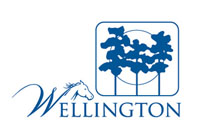BY PAUL GABA
Improvements along Wellington’s many equestrian bridle trails, both completed and in process, were up for discussion at the Wednesday, Aug. 2 meeting of the Wellington Equestrian Preserve Committee.
Wellington Project Director Michael O’Dell spent about an hour discussing the committee’s 10-year Capital Improvement Programs (CIP) plan, which focuses primarily on improving the various riding trails running within Wellington. It calls for spending approximately $3 million on such improvements by 2025.
O’Dell’s presentation included showing updates to the November 2015 CIP, with a focus on several projects that have been completed in the past 21 months.
Three projects are now finished. One is the Blue Trail Crossing, which extends an existing culvert within the C-23 Canal crossing, widening this link from the Blue Trail (Saddle Trail Park) to the Yellow Trail (Pierson Road).
The second is the Red Trail/C-2 Canal right of way, which called for installation of asphalt millings from Greenview Shores Blvd. to 40th Street (C-24 Canal), to stabilize soils due to the increase in usage.
The third, originally part of the Year Nine (2023-24) Phase, were improvements of approximately 3,000 feet between South Shore Blvd. and the C-6 Canal, north of Pierson Road across from the Palm Beach International Equestrian Center.
Asphalt millings are often considered recycled asphalt pavement — essentially, they are former asphalt installations crushed into gravel.
“Our primary goal is to try to keep grass [on the trails] — that’s our number one focus,” O’Dell said. “Where we have not been successful, because of the traffic, we go to millings. We now have the equipment in place to maintain the millings, so they don’t chunk up during the summertime, so we can keep the surface smooth, but stiff enough for horses.”
Improvements along the Brown Trail — considered the most expensive part of the entire CIP — will begin in the summer of 2018, according to O’Dell.
This calls for approximately 2,000 feet of overall bridle path to be improved: 1,000 feet along the east side of Wellington Trace, and another 1,000 feet along the north side of the C-15 Canal, connecting Saddle Trail Park (the Blue Trail) to Paddock Park (the Brown Trail). These improvements would include two sections of road striping for equestrian crossings, and a culvert crossing within the C-11 Canal North side of the C-15 Canal.
O’Dell said this canal crossing would link the east and west portions of the Brown Trail in Paddock Park and would connect between Paddock Park and Saddle Trail Park.
“The grant money is in the program, and our consultants are working on design,” O’Dell said. “But we might hold off due to being in season when we’re ready to go with it, so it might not start until the summer of 2018.”
Two other improvements that are part of the Year Two (2016-17) Phase are the White Trail improvement, where asphalt millings will be installed along the north and south sides of the C-24 Canal between South Shore Blvd. and Flying Cow Road, and the Greenbrier Blvd./Ousley Farms Road crossing, which was initially proposed as an equestrian crossing with a flashing light for the Red Trail along the C-2 Canal. The latter improvement is developer-driven.
Three improvements are on the agenda for Year Three (2017-18). One is the White Trail improvements to link the White Trail to Flying Cow Road and the Wellington Environmental Preserve at the Marjory Stoneman Douglas Everglades Habitat. This crossing is planned to include an equestrian roadway crossing with a flashing light to denote the crossing at Flying Cow Road. The other two would see asphalt millings installed along the Orange Trail south of the C-25 Canal (50th Street) and the Gray Trail south of the C-6 Canal (130th Street).
The 10-year CIP is always being reviewed, O’Dell said, because shifting demographics can lead to adjusting the size and scope of some proposed projects.
“These are projects we are anticipating doing, but we will look at them and see if they are necessary,” O’Dell said of projects that are beyond five years out. “We are speculating traffic will increase, and we would need footing improvements because we expect… additional equestrian traffic. We will monitor that, and we will move things around if we need to.”
Committee Vice Chair Kristy Lund voiced concern that the CIP does not call for improvements to the Palm Beach Little Ranches area until Year Eight.
“Little Ranches shouldn’t have to wait eight years,” Lund said about the isolated Wellington enclave off Southern Blvd.
Equestrians in the Little Ranches neighborhood have been asking for a fair share of financing to improve their community’s trail system, which they contend has fallen victim to recent road paving and drainage improvements, she said.
“As a committee, you may want to readdress some of this over time,” O’Dell said.








